纯态、混合态、密度矩阵归纳
Haug 的半导体光学书65页
直接说:半导体中能带的电子不是纯态,而是处于混合态。必须用密度矩阵描述。
金老师高量讲义中密度矩阵
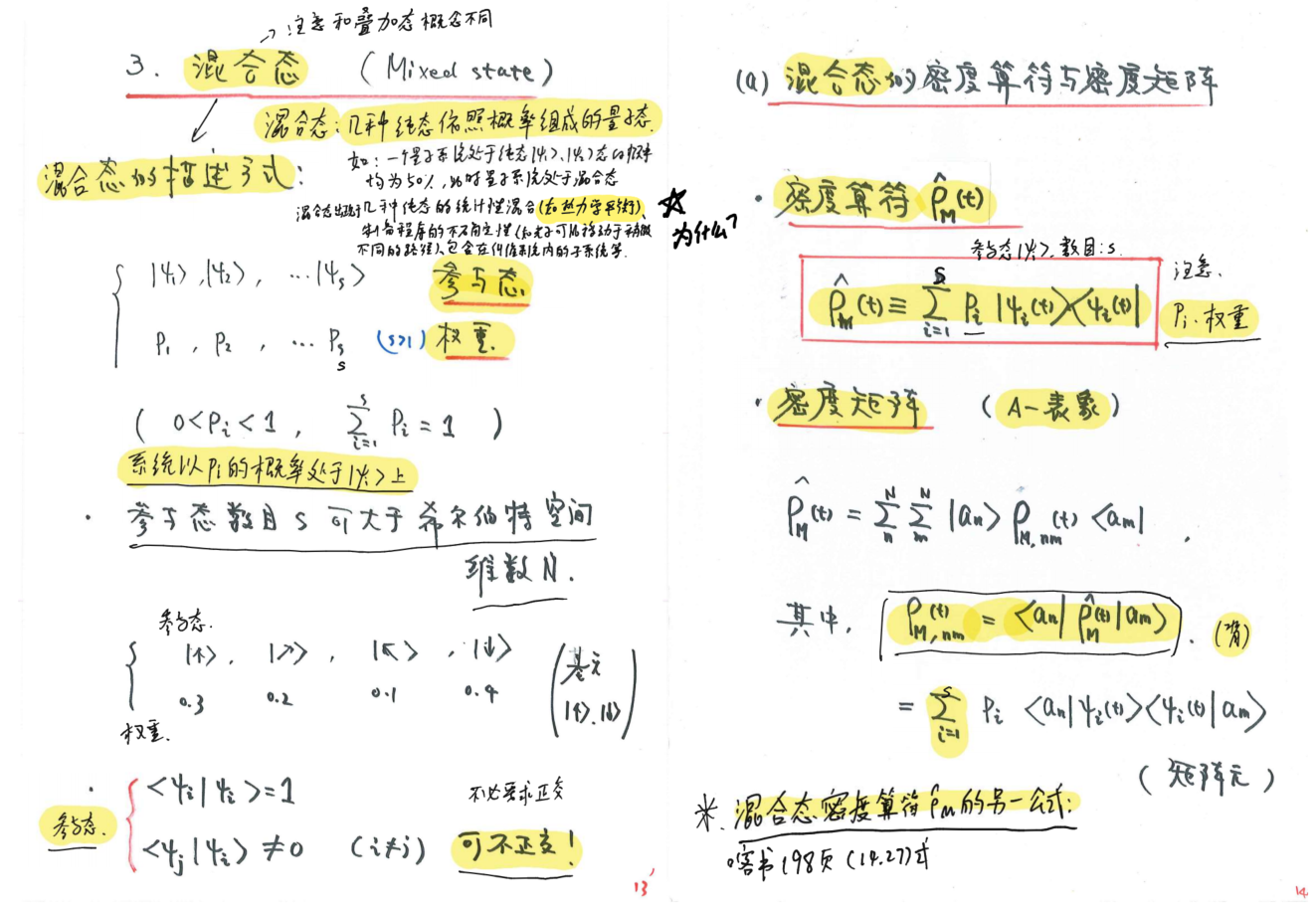
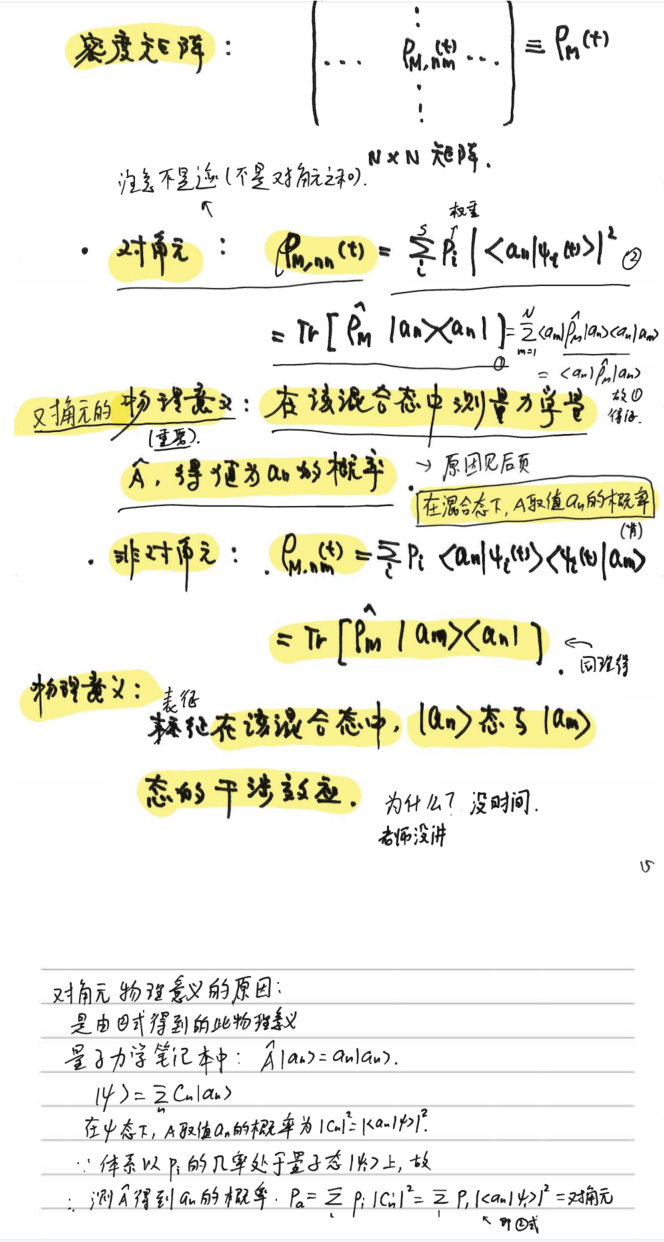
混合态平均值公式的含义: 在混合态中,既计算了量子力学平均,也计算了统计平均
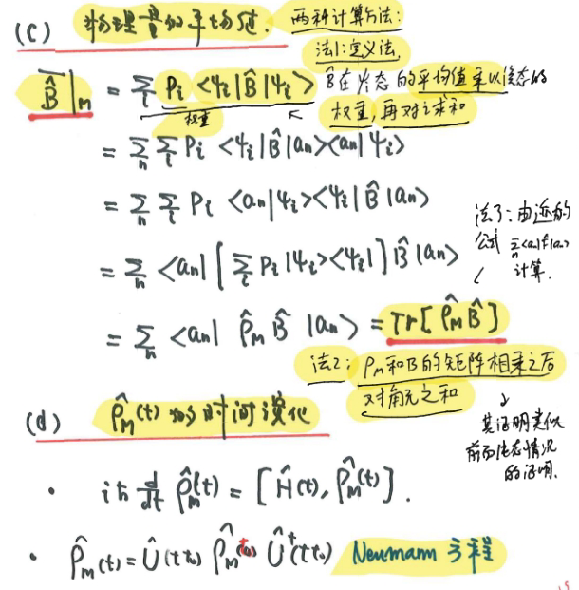 但这里的前提是:****是完备集。(特别重要,必须满足此前提,才成立)
但这里的前提是:****是完备集。(特别重要,必须满足此前提,才成立)
特别注意,根据混合态的物理意义:必须用混合态的语言来描述系统的宏观状态(系统的宏观状态就是一个混合态)[1]知:在混合态中这样计算的平均值 是:既计算了量子力学平均,也计算了统计平均(即系综平均,因为正则系综就是混合态)。
为知笔记中密度矩阵的相关笔记内容:
纯态和混合态的区别:纯态就是系统处于和的叠加态这样一个新态。混合态是系统一定概率可能处于或
喀书:纯态就是系统处于和的叠加态这样一个新态。混合态是系统一定概率可能处于或。
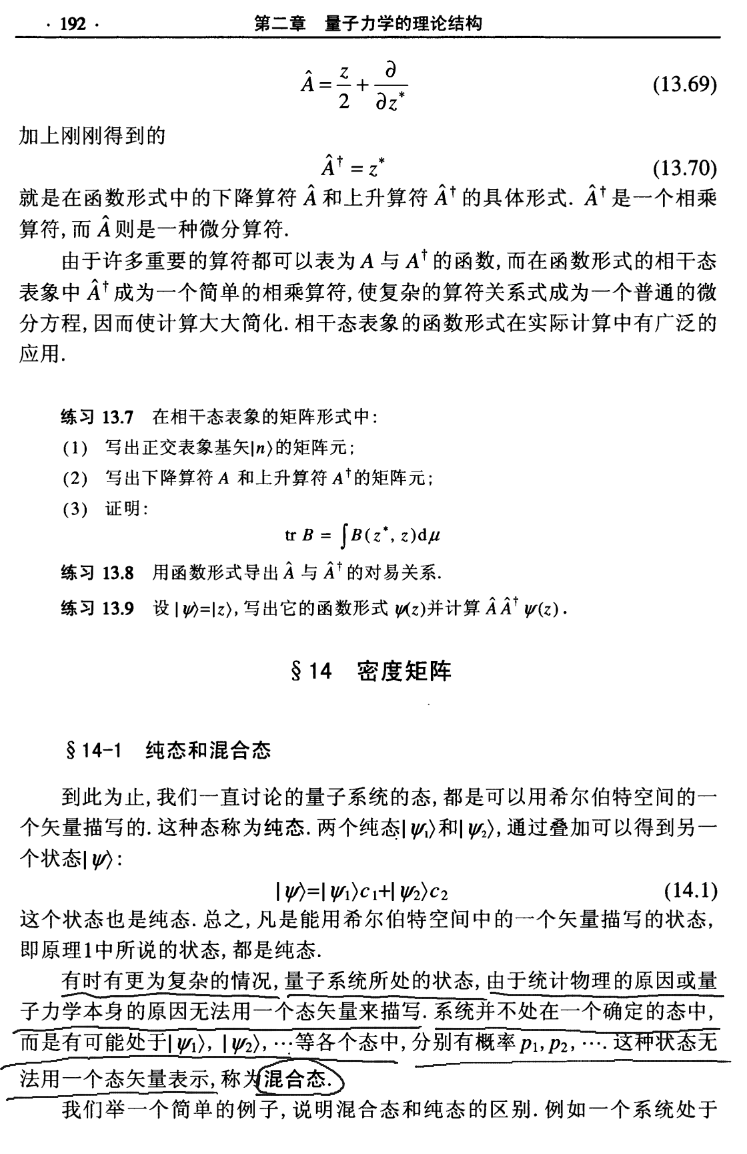


混合态的物理意义:必须用混合态的语言来描述系统的宏观状态(系统的宏观状态就是一个混合态)
先复习统计物理笔记本中关于系综、正则系综:关于林书的笔记:
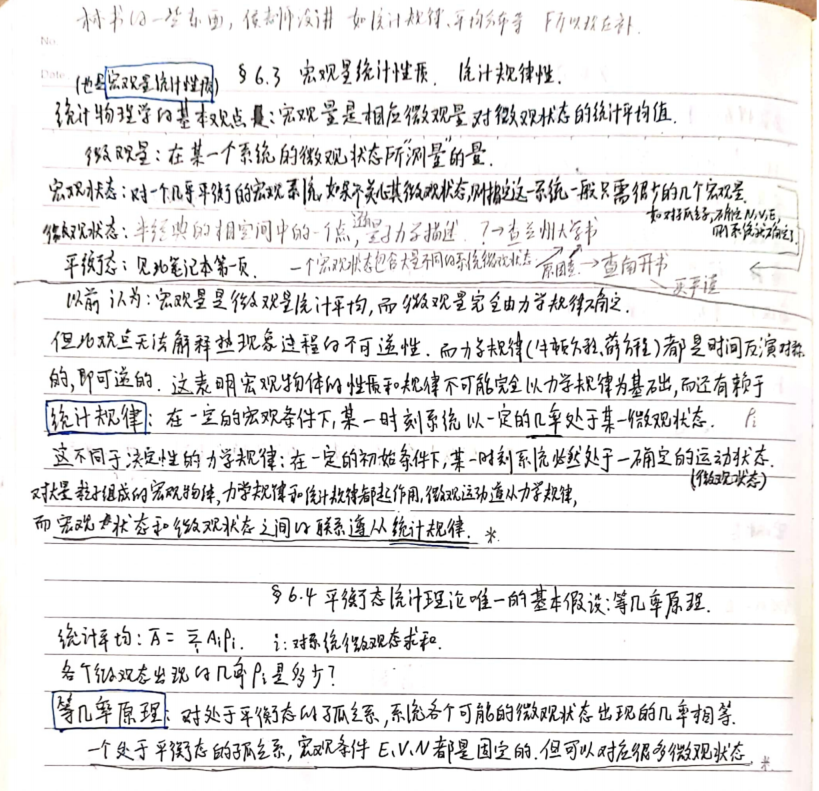


在热统笔记本关于林书的笔记非常重要,系统的微观状态不同于系统的宏观状态。力学规律确定了系统的微观状态,但不能确定宏观状态,还需要统计规律。所以,一个波函数能描述系统的微观状态,但不能描述系统的宏观状态,必须用混合态的语言来描述系统的宏观状态。这也就是混合态的意义!(这也是量子力学平均后还需要统计平均(在Haug的半导体光学书90页称之为系综平均)的原因**)
系统的宏观状态就是一个混合态! 系统的微观状态作为参与态。
热统林书很重要,可以复习林书从178页开始。
量子统计、正则系综中密度算符的应用
金老师讲义:高量+
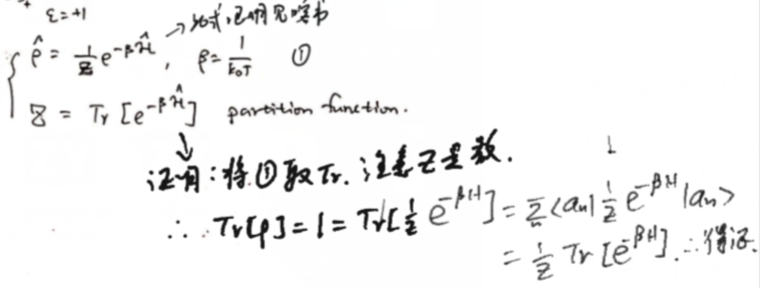
喀书:
正则系综是混合态!(其实系综就是混合态)
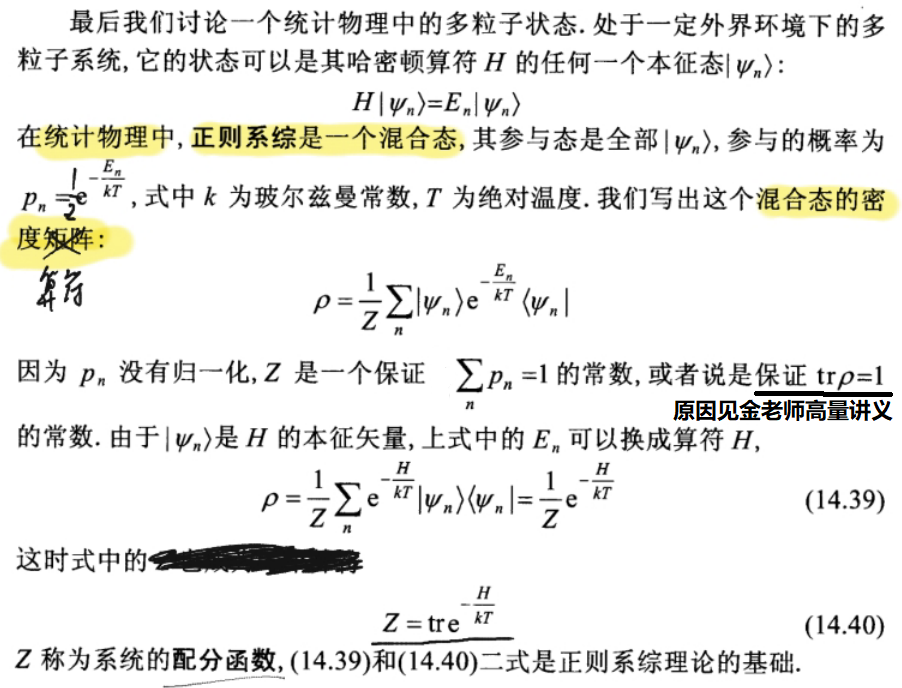 (注意这是多粒子密度算符,不是k态单粒子密度算符)
(注意这是多粒子密度算符,不是k态单粒子密度算符)
系综:具有相同的力学性质,在相同宏观条件下,大量系统构成的集合。见本科统计物理笔记本
曾书卷二20页:
例 6 与大热源达到平衡,温度为 的体系(正则系综),处于非纯态(即混合态),用密席算符
描述, 为 Boltzmann 常量,H 为 Hamilton 算符, 称为配分函数(partition function). 在能量表象中(基矢 , 密度矩阵为
以谐振子为例,
谐振子处于 能级的概率为
所以能量平均值为
可以看出, 当 时, , 与经典统计 (Boltzmann 统计)给出的结果相同. 相 反, 在低温极限 下, , 即所有谐振子在低温极限下, 都倾向于布居在基 态上.
约化密度算符
见金老师高量讲义:
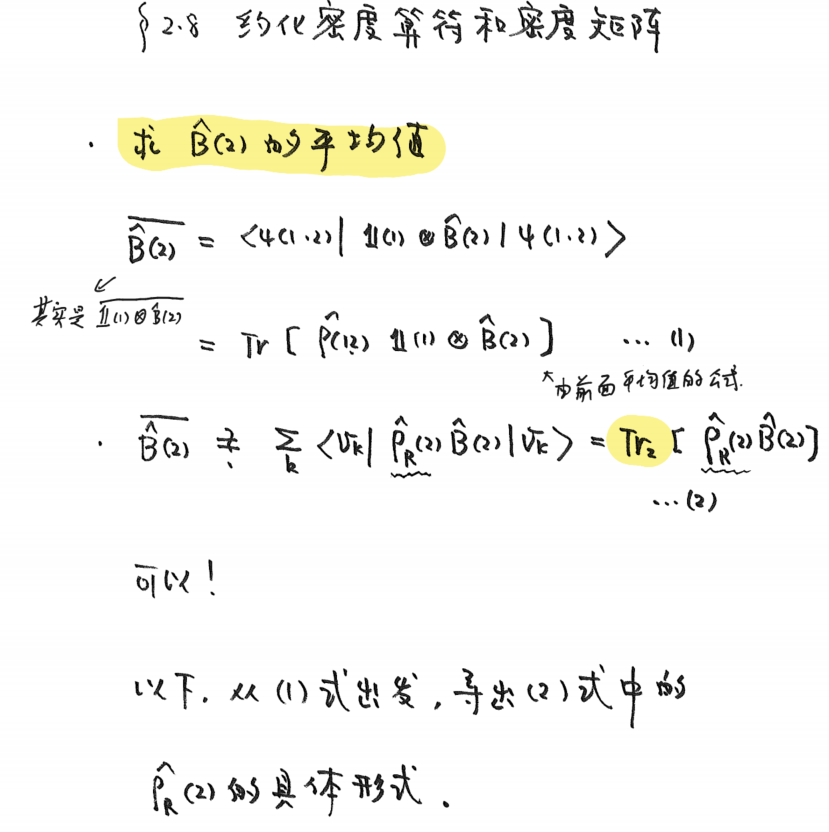
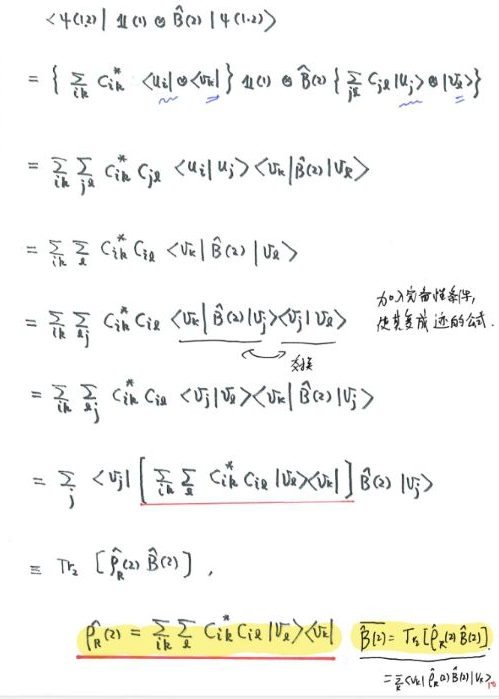

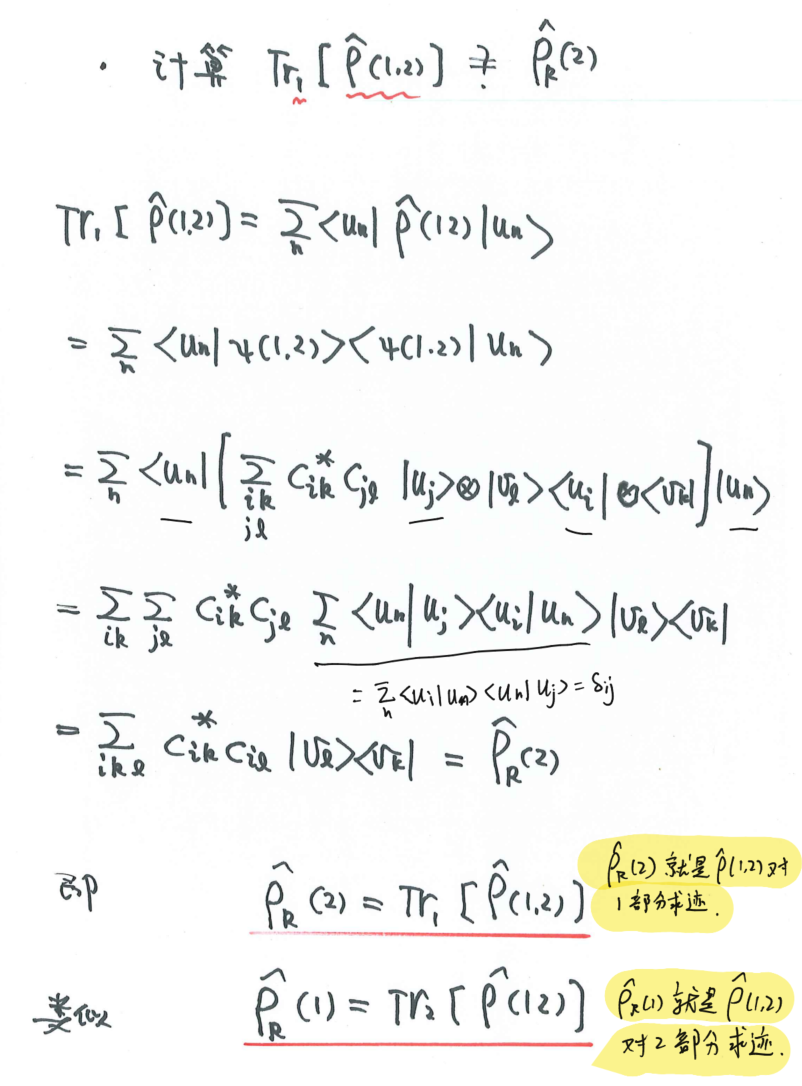
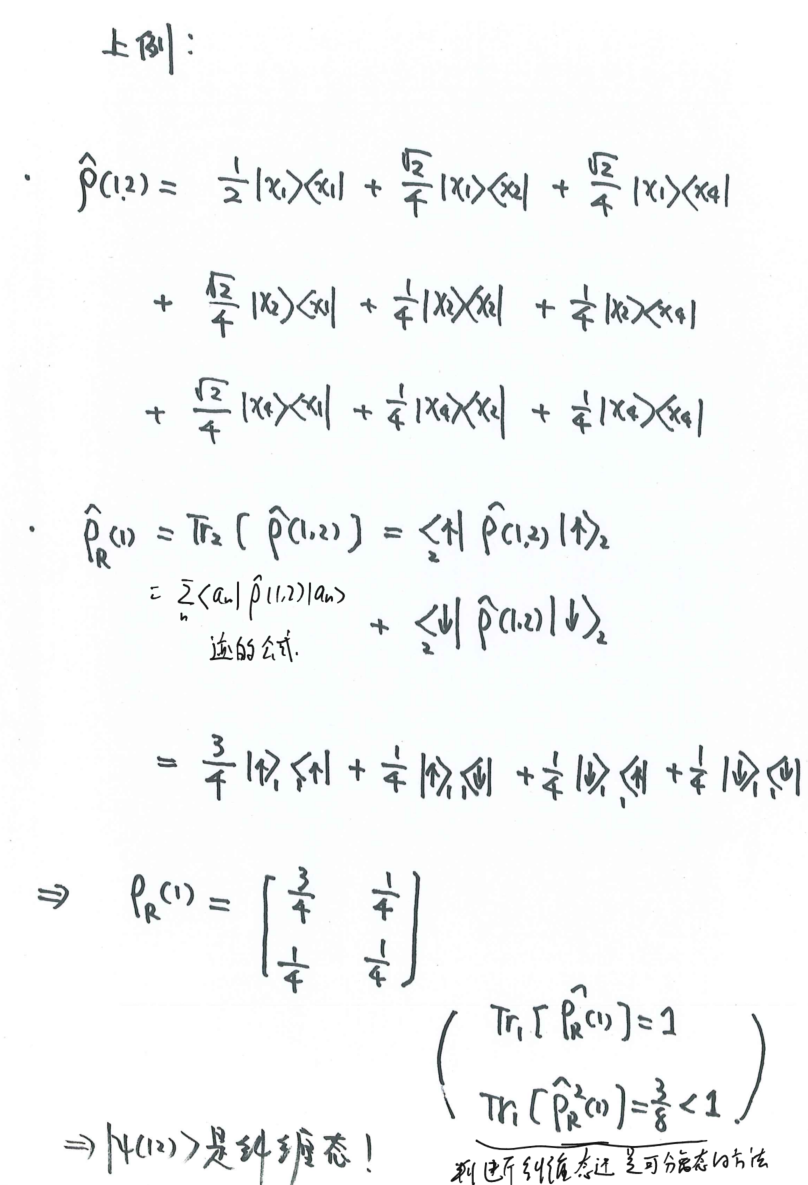
纯态和混合态的实际例子:
Density Matrix (virginia.edu):
Pure States and Mixed States
Our treatment here more or less follows that of Sakurai, beginning with two imagined Stern-Gerlach experiments. In that experiment, a stream of (non-ionized) silver atoms from an oven is directed through an inhomogeneous vertical magnetic field, and the stream splits into two. The silver atoms have nonzero magnetic moments, and a magnetic moment in an inhomogeneous magnetic field experiences a nonzero force, causing the atom to veer from its straight line path, the magnitude of the deflection being proportional to the component of the atom's magnetic moment in the vertical (field) direction. The observation of the beam splitting into two, and no more, means that the vertical component of the magnetic moment, and therefore the associated angular momentum, can only have two different values. From the basic analysis of rotation operators and the properties of angular momentum that follow, this observation forces us to the conclusion that the total angular momentum of a silver atom is . Ordinary orbital angular momenta cannot have halfinteger values; this experiment was one of the first indications that the electron has a spin degree of freedom, an angular momentum that cannot be interpreted as orbital angular momentum of constituent parts. The silver atom has 47 electrons, 46 of them have total spin and orbital momenta that separately cancel, the has no orbital angular momentum, and its spin is the entire angular momentum of the atom.
Here we shall use the Stern-Gerlach stream as an example of a large collection of quantum systems (the atoms) to clarify just how to describe such a collection, often called an ensemble. To avoid unnecessary complications, we only consider the spin degrees of freedom. We begin by examining two different streams:
Suppose experimentalist prepares a stream of silver atoms such that each atom is in the spin state :
Meanwhile, experimentalist prepares a stream of silver atoms which is a mixture: half the atoms are in state and half are in the state : call this mix .
Question: can we distinguish the stream from the stream?
Evidently, not by measuring the spin in the -direction! Both will give up of the time, down .
But: we can distinguish them by measuring the spin in the -direction: the quantum state is in fact just that of a spin in the -direction, so it will give "up" in the -direction every time-from now on we call it , whereas the state ("up" in the -direction) will yield "up" in the -direction only of the time, as will .
The state is called a pure state, it's the kind of quantum state we've been studying this whole course.
The stream , in contrast, is in a mixed state: the kind that actually occurs to a greater or lesser extent in a real life stream of atoms, different pure quantum states occurring with different probabilities, but with no phase coherence between them. In other words, these relative probabilities in of different quantum states do not derive from probability amplitudes, as they do in finding the probability of spin up in stream : the probabilities of the different quantum states in the mixed state are exactly like classical probabilities.
That being said, though, to find the probability of measuring spin up in some such mixed state, one first uses the classical-type probability for each component state, then for each quantum state in the mix, one finds the probability of spin up in that state by the standard quantum technique.
Therefore, for a mixed state in which the system is in state with probability , the expectation value of an operator is
and we should emphasize that these do not need to be orthogonal (but they are of course normalized): for example one could be , another . (We put the usually omitted in for emphasis.) The reason we put a hat on here is to emphasize that this is an operator, but the are just numbers.
量子退相干
量子退相干到底是什么意思? - 知乎 (zhihu.com):
见:量子退相干到底是什么意思? - 也疏寒的回答 - 知乎 写得好!
https://www.zhihu.com/question/313273016/answer/633965523
混合态的物理意义:必须用混合态的语言来描述系统的宏观状态(系统的宏观状态就是一个混合态)
↩︎



【推荐】国内首个AI IDE,深度理解中文开发场景,立即下载体验Trae
【推荐】编程新体验,更懂你的AI,立即体验豆包MarsCode编程助手
【推荐】抖音旗下AI助手豆包,你的智能百科全书,全免费不限次数
【推荐】轻量又高性能的 SSH 工具 IShell:AI 加持,快人一步
· 物流快递公司核心技术能力-地址解析分单基础技术分享
· .NET 10首个预览版发布:重大改进与新特性概览!
· AI与.NET技术实操系列(二):开始使用ML.NET
· 单线程的Redis速度为什么快?
· Pantheons:用 TypeScript 打造主流大模型对话的一站式集成库